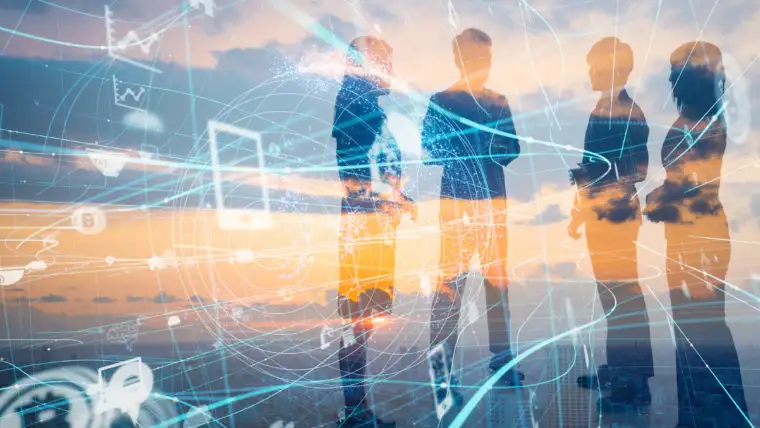In the Intelligent Age, rapid technological innovation is reshaping how we live.
Collectively, we must understand AI’s immense value, especially in strengthening our intellectual capital.
We’ve identified four areas in which AI can positively influence organizations.
세계경제포럼, 2025년 1월 20일 게시
Ahmed Galal Ismail
Chief Executive Officer, Majid Al Futtaim Holding

Something profound is happening at the intersection of human potential and technological capability. We’re no longer talking about AI as a distant, abstract concept, but as a tool with immense possibility woven into our lives and fundamentally reshaping how we understand value, connection, and progress.
It’s clear that the capabilities AI offers us are far more nuanced than simple technological replacements. Instead, this new era is about the complex relationship between human and machine intelligence. In this Intelligent Age the most exciting breakthroughs are not about what AI can automate and replace but what it can augment.
Have you read?
- The Intelligent Age: A time for cooperation
- What companies do now will determine their future in the Intelligent Age
At Majid Al Futtaim, we place great stock in investing in five types of capital: financial, intellectual, human, reputational and social. Together these create a framework for a cohesive organization, with a clear and aligned vision and ambition.
To me, AI is an enhanced form of intellectual capital, working alongside and augmenting the four other forms of capital in our organizational model. Here’s how I see AI influencing each of those four interrelated dimensions.
1. Financial: Improving efficiency, understanding customers, guiding investments and supporting new business models
Some of the ways AI complements financial capital have been much discussed: driving greater efficiency and productivity and lowering costs and risks. AI’s ability to analyse vast amounts of financial data to identify trends and make predictions leads to better decision-making and risk management, for example.
But there are less obvious ways AI drives up financial capital too. By helping us better understand our customers we can improve their experience and deliver consistent high-quality service.
AI can also unlock new business opportunities – our new vertical Precision Media being a good example of this. We use data and customer insights to help brands better target their marketing and influence purchasing decisions.
2. Human: Upskilling employees and improving engagement
The strength of any organization is its people – and AI provides us with a fantastic opportunity to grow our intellectual and human capital through personalized learning experiences and intelligent support systems.
AI-powered learning platforms can create tailored educational journeys, adapting in real time to individual learning styles and knowledge gaps. This approach goes beyond traditional training models, offering dynamic, responsive skill development. This benefits businesses by ensuring they are building future-ready workforces and helps individuals by fostering individual growth and ensuring they remain competitive in an evolving job market. For instance, IBM’s partnership with Coursera uses AI to suggest relevant learning paths based on user preferences and career goals, which has resulted in a notable increase in course completion rates and skill acquisition.
AI tools can also provide insights into employee engagement, helping organiszations understand and improve workplace dynamics. By analysing sentiment, productivity metrics, and professional development trajectories, companies can create more supportive, responsive work environments that prioritize employee well-being and retention.
3. Social: Amplifying collaborative problem solving
The potential applications of AI for good are immense and represent a profound opportunity for global leadership and collective problem solving. However, a McKinsey study suggests that 72% of the respondents observed that most efforts to deploy AI for social good to date have focused on research and innovation rather than adoption and scaling. While overcoming these challenges, organizations should use technology and work together to address complex humanitarian challenges, from healthcare accessibility to climate resilience.
A great example of this is the UAE’s partnership with the Bill & Melinda Gates Foundation to use AI to support vulnerable smallholders to become more climate resilient. The collaboration will provide funding to initiatives such as AI-enabled weather forecasting, pest management, and advisory services.
4. Reputational: seizing the opportunity to underline brand trust
In an era of deepfakes and a growing global trust deficit, AI provides both a reputational risk and an opportunity for organizations. AI-generated deepfakes, have become a billion-dollar business risk where one fake video or image can diminish a company’s value in minutes.
A PwC research suggest that two-fifths of CEOs believe that used in the right way AI has the potential to enhance trust with stakeholders. But a similar proportion see reputational risks emerging. Therefore, businesses must seize the chance to underpin trust in their brand by using AI strategically and responsibly.
AI also presents opportunities to monitor and manage public image and brand reputation in real time. For example, AI-driven analytics can monitor customer feedback and social media sentiment allowing organizations to intervene and address any issues, respond rapidly to negative feedback and avert potential crises.
Navigating the Intelligent Age
Realising the potential of the Intelligent Age will be a collaborative evolution. We are not passive recipients of technological change but active co-creators of a new understanding of intelligence, creativity, and human potential.
The future belongs to organizations that can seamlessly integrate technological intelligence with human creativity, social responsibility, and strategic vision. As AI continues to evolve, it will undoubtedly play a crucial role in helping companies navigate complexity, drive innovation, and create meaningful value across multiple dimensions.

